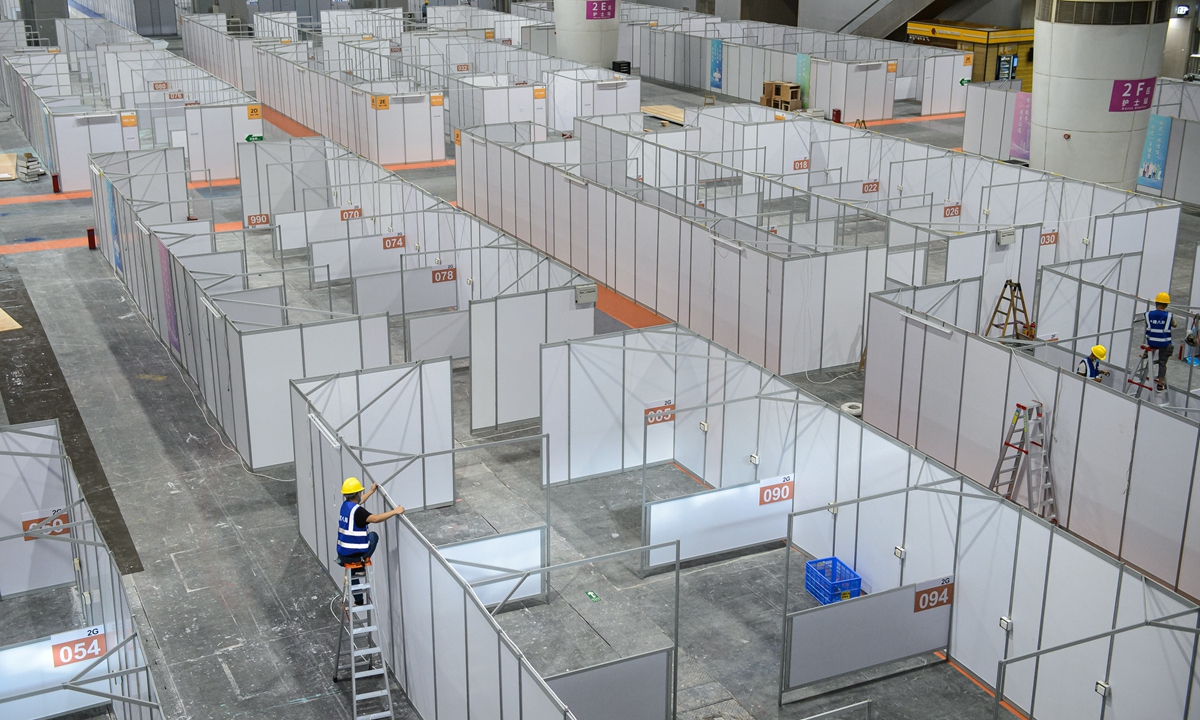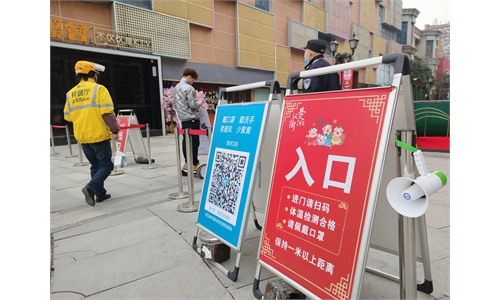Multiple regions learn from Shanghai’s experience, take proactive measures for Omicron spread

Workers rush to build a makeshift hospital at Pazhou International Convention and Exhibition Center in Guangzhou, South China's Guangdong Province, on Monday. Photo: VCG
Considering the lessons from Shanghai's response to the Omicron resurgence, a number of provinces and cities across China are taking more decisive preventive measures to screen out possible COVID-19 infections through massive nucleic acid testing.
Some cities are accelerating the construction of Fangcang makeshift hospitals to be well prepared for potential new outbreaks, echoing the country's dynamic-zero strategy.
Public health experts said that such preparations for the worst scenarios of flare-ups signaled a top-down recognition of China's dynamic zero COVID strategy, which is still the most suitable response to Omicron. The essence of the strategy indicates that when individual cases or epidemics occur, they can be quickly found and curbed, with transmission routes cut off to prevent continuous community transmission.
After reporting 23 infections and detecting another transmission chain of the Omicron variant, Guangzhou, capital city of China's Guangdong Province, announced on Sunday plans to suspend on-site activities in all kindergartens, primary schools and middle schools starting on Monday. It also urged local supermarkets and companies to work on emergency supplies of daily necessities.
Other places, with or without new infections, appeared to learn from Shanghai's experience by taking more strict measures as early as possible, especially when the speed of the Omicron variant's transmission poses a challenge and requires more rapid treatment and decisive measures.
After Central China's Hubei Province reported 33 asymptomatic cases on Sunday, cities in the province such as Yichang and Jingzhou began citywide nucleic acid testing on Monday. The local authority in Yichang, a city with about 3.8 million people, explained why it's important to conduct tests even when there are no reports of domestically transmitted cases.
"Through full-scale nucleic acid testing, we'll find the potential risks to implement the dynamic-zero tolerance strategy, to ensure that all the preventive measures take place ahead of the virus' spread," the local government said.
Wuhan has required those who take public transport vehicles such as buses and subways to hold a 48-hour valid negative nucleic acid test result, after 12 asymptomatic cases were reported in the city.
Multiple rounds of nucleic acid testing could help find potential infections in communities, as Omicron causes infections without symptoms with hidden transmission routes, a doctor from Hubei who is now supporting the anti-epidemic work in Shanghai and who preferred not to be identified told the Global Times on Monday when talking about Shanghai's experience.
"When we arrived here, there was large-scale community transmission," he said, noting that without identifying potential infections as early as possible when there's large-scale community transmission, it would heavily weigh on local authorities in handling the epidemic.
After neighboring Jize county, North China's Hebei Province reported some 40 asymptomatic cases in early April, the Nanhe district of Xingtai city put the entire region on standstill. That has been the case for nearly two weeks, with the district locking down residential communities, suspending business and launching seven rounds of nucleic acid testing.
Local residents said they are now allowed to step out of their communities but still cannot go out of the district as traffic routes are blocked.
The Global Times learned from a local official that in the face of pressure from neighboring regions, Nanhe district acted quickly to avoid the spread of Omicron within the city. Other urban regions of Xingtai city also started to collect information of residents as preparation for mass nucleic acid testing if the neighboring region's epidemic expands.
Besides massive nucleic acid testing, cities like Guangzhou and Nanjing in East China's Jiangsu began accelerating the construction of Fangcang makeshift hospitals.
Local authorities in Guangzhou announced on Sunday that they are renovating part of the exhibition hall of the world-renowned China Import and Export Fair into a makeshift hospital amid the latest COVID-19 spike. Nanjing immediately launched the construction of four Fangcang makeshift hospitals on Sunday, with thousands of workers busy renovating them day and night, according to the local health authority.
Those are preventive measures to help ease the burden on hospitals. When facing severe outbreaks, authorities can divert patients with mild symptoms to Fangcang makeshift hospitals for collective quarantine in order to save medical resources for those in severe condition.
Preparing in advance to build makeshift hospitals is in line with our dynamic-zero tolerance strategy, Chen Xi, an associate professor of public health at Yale University, told the Global Times on Monday.
China's top health authority earlier said that each province must have two to three Fangcang makeshift hospitals, which have been playing a crucial role in quarantining silent carriers and mild cases to ease the burden on the public health resources.
Although some experts previously suggested that asymptomatic cases and those with mild symptoms could stay home for quarantine, Liang Wannian, head of the COVID-19 Expert Team of the National Health Commission, said at a press conference on Sunday that insisting on collective quarantine for mild and asymptomatic cases is necessary.
If those people are isolated at home, facilities and equipment such as sewers and ventilation systems are always at risk of transmission, Liang said, noting that collective quarantine ensures people's health and safety, which is still necessary under the current situation.



